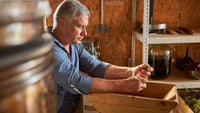
Aging wine is a funny thing. There isn’t a perfect method to it - every winemaker, wine region, and passed-down tradition has its rhyme or reason for what they do. That’s why it's good to know the basics of Italian wine-aging methods so that you have a better idea of what’s inside your bottle!
From barrique to cement eggs, winemakers across Italy choose to age wines with their stylistic approach. Let’s dive into them and also learn a little Italian along the way.
The Barrel Methods
When many people think about aging wine, they think of barrels. It's only natural as the classic imagery of winemaking is - well - racks of barrels. And, it's still the most common way to age red wine.
When it comes to Italian wines, there are a few methods producers use to age their wines. The choice depends on a few factors: grape type, winemaking tradition, and style. Time to explore the two types of barrels typically used in Italian winemaking, their influence on the wine, and the kinds of wines you will find using these barrel methods.
Barriques

Small, 225-liter barrels (also known as barriques) are a major tool in Italian red winemaking. The name gives away their French origins - the wines of Burgundy and Bordeaux are also traditionally aged in barrique.
So, what is the point of barrique aging? A barrel's unique shape and size have a special effect on the wine as it ages. Barrique has thin staves, which let more oxygen travel through the barrel, speeding up the wine maturation process. This process softens tannins more quickly. Also, the barrel's staves are curved through a careful toasting process. The heat seasons the wood, thus imparting flavors to the wine. The intensity of these flavors will depend on how old the barrique is and how long the wine rests in the barrel.
Barrique aging can be found across numerous Italian wine appellations, particularly the most famous ones. Wineries in Chianti Classico, Amarone della Valpolicella, and even Barolo utilize barrique aging. What all these appellations have in common are very intense wines that could benefit from the intimacy and support that barriques offer. In Piedmont, you can find white wines aged in barrels, developing body and complexity. Don’t be surprised to find Chardonnays from Piedmont (yes, we know it's French!) aged for long periods in barrique.
Recently, there has been more resistance towards barrique aging across the Italian wine industry, especially among young producers. Seeing barriques as potentially harmful to the innate nature of the wine, many opt for other aging methods - such as much bigger barrels.
Botti
There are small barrels. Then, there are really big barrels. These are botti - giant vessels that can hold anywhere from 5000 to 10000 liters. Now, that’s a ton of wine!
Of course, you may be wondering why would wineries invest in such huge barrels. First, botti are traditional to Italian winemaking. They date back as far as the Roman times to store wine, evolving through the centuries to become more reliable vessels for aging. Botti are made from Slovenian oak (Slovenia borders Italy just to the east,) but nowadays you can also find botti made with Austrian or Hungarian oak.
The lofty size of botti leads to a slower aging process, which many winemakers believe urges red wines to develop much more complexity and age-ability. Also, botti impart substantially less oak on the wine, permitting the wines to develop and express more of their character.
Now is the time to bring up a perfect barrique vs botti example. Barolo has quite a contentious history over these two aging approaches. It all began in the 1980s when the notorious Barolo boys tried to revolutionize the old method of botti aging - which took much longer and yielded wines that needed even more time and love aging in the bottle. The response shifted the perspective on how to treat Nebbiolo, one that remains pretty controversial today. The traditionalists - though - have recently prevailed in returning to Barolo’s botti roots.
The Non-Barrel Methods
Of course, barrels aren’t the only way to age wine. There are other routes winemakers go to age their wines, especially Italian white wines.
Stainless Steel
A beloved, more modern wine aging vessel, stainless steel has proved to be quite a reliable tool for Italian winemakers. Its neutral personality makes it versatile for aging for both red and white wines alike. It gives winemakers control of the wine’s exposure to oxygen (remember barrels are more porous!), preserving fresh aromas in wines. This is desirable for white wines, which often can lack the anti-oxidants red wines have from their longer macerations (or skin contact.)
What are a few wine examples here? The simplest one is Pinot Grigio. Liters of this wine is glugged because of its easy body and freshness. The stainless steel retains cold temperatures to preserve Pinot Grigio’s acidity and simplicity.
Now, you must be wondering - are there any red wines that age in stainless? Why yes there are.
High-altitude Pinot Nero made in both the regions of Valle d’Aosta and Alto Adige are often aged in stainless steel, preserving the wine's fresh fruit character and herbal aromas. You can also find Sangiovese aged in stainless steel, preserving the grape's innate cherry flavors and bright acidity.
Cement
Arguably the best of both worlds, cement aging continues to be a winemaker’s best friend. It comes through as an equalizer. Sometimes stainless steel is too neutral, creating wines that can be too bright and often one-dimensional. Enter: cement tanks. These vessels offer a similar porosity to barrels without any imparting flavor. This allows wines to develop more complexity than a stainless tank can often offer.
Of course, this isn’t all set in stone. The wine’s character rests on many factors, from grape type to maceration to the winemaker’s overall approach. Wines aged in stainless can be very complex (for example, many Fiano di Avellino wines see aging in stainless and are stunning.) In short, it all depends on the winemaker’s thoughtfulness in the process.
Back to cement - truthfully, it isn’t a traditional practice in Italian winemaking, but rather a result of modern advances in winemaking. You can find cement eggs across wineries all over Italy. It's fascinating how cement eggs are now tools to age certain Etna Rosso and even Chianti Classico wines. These two red wines are made with tannic and acidic grape varieties that evolve gracefully in cement with the right approach.
Amphora

The cool kid on the block, amphora aging has resurrected from its ancient past as a popular aging method again in Italy. One reason is - they require less cleaning maintenance than most other vessels! Winemakers spend a lot of time cleaning so that is most definitely a plus.
Amphoras are made of terracotta, another porous material that doesn’t influence the flavor of the wine. Instead, it permits a slow oxygenation process that balances the acidity and tannin in wine. This occurrence is one motive for amphora aging of orange wines - wines that see an extended skin maceration. Skins add tannin and anti-oxidative properties, making them more adaptable to more oxygenated aging vessels! In addition, amphoras are admired for their ability to allow a wine’s innate fruit character to blossom.
Amphora aging happens in many Italian wine regions. Winemakers are either experimenting or going back to their region's roots with amphora winemaking, which you can see in the Italian south. One spectacular example is Elena Fucci’s amphora-aged Aglianico, paying homage to the Hellenic roots of this mighty red grape and its homeland.
A Term to Know: Riserva
According to a wine’s appellation, there may be specific aging requirements such as length or even the kind of vessel for aging. Regardless, there are riserva wines in various Italian wine appellations for white and red wines alike.
That said, you should know that these riserva wines do always require additional aging. The extra TLC is one of the reasons these wines are considered riserva! For white wines, it's around 1 year longer than the general appellation requirement, and for red wines, it's two years more.
Getting to the Bottles with Big Hammer Wines
Once a wine goes from stainless, cement egg, or barrel to bottle, you may find it in your hands from Big Hammer Wines. Now, what do you do with it? Our wine experts are always ready to guide you on whether to further age or sip your wine right away. And, we already have a guide ready to get you ready to shop and prepare all your questions.
Big Hammer Wines
The wine experts at Big Hammer Wines taste thousands of wines every year from around the globe, looking for quality and value. This special offer reflects the passion we have for our clients.
Discover the world through its wines, Click Here! Visit Bighammerwines.com and become a wine expert!


